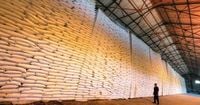On Monday, March 17, 2025, President Luis Abinader of the Dominican Republic announced that the U.S. government has lifted its restrictions on Central Romana Corporation, allowing the company to resume sugar exports. This marks a significant change after two years of limitations imposed under the Biden administration, primarily due to allegations of forced labor in the company's operations.
During his remarks at a press conference held by LA Semanal with the media, Abinader expressed, "Therefore, we return to normalcy and Central Romana will now be able to export sugar (and its other products) to the United States, just as it has always done." The lifting of restrictions paves the way for Central Romana to once again send its sugar and sugar-based products to the U.S. market, ceasing what had been an extended interruption.
The restrictions had been implemented back in November 2022 when the U.S. Customs and Border Protection (CBP) halted shipments of raw sugar and related products. This action was taken following allegations of forced labor raised against Central Romana. The CBP identified five indicators of forced labor during its investigations, which included abuse of vulnerability, isolation, retention of wages, abusive working and living conditions, and excessive overtime. These findings triggered the issuance of a Withhold Release Order (WRO) against the company.
In the backdrop of the lifting of these restrictions, Sonia Guzmán, the Dominican ambassador to the United States, applauded the initiative of the U.S. government. "The normalization of Dominican sugar's entry into the U.S. market is a significant achievement that reflects the strengthening of trade relations and confidence in Dominican products," remarked Guzmán. She highlighted the collaborative efforts that involved various Dominican ministries and the Central Romana Corporation, showcasing a united front in addressing the concerns raised by the U.S. government.
Guzmán noted that the embassy's team coordinated closely with the Ministry of Foreign Affairs, Ministry of Industry and Commerce, Ministry of Agriculture, and other relevant entities to share extensive audits and documentation with the U.S. authorities. Over the past two years, Central Romana has provided CBP with all required independent audits from external organizations and has documented their best practices aimed at resolving the forced labor allegations. The company expressed satisfaction that the U.S. administration has reviewed all evidence provided and agreed that there was no basis for continuing the WRO.
In his announcement, Abinader emphasized the positive impact of this decision on both the sugar industry and employment in the region. Central Romana employs over 25,000 people, primarily in the eastern part of the country. Due to previous restrictions, the Dominican Sugar Institute (Inazucar) had to redistribute sugar export quotas, allocating significant portions to other manufacturers, which hampered Central Romana’s ability to operate at full capacity.
For the fiscal year 2025, the Dominican Republic is set to export approximately 189,343 tons of raw sugar to the U.S., demonstrating the importance of this market for the nation. The U.S. continues to be the primary trading partner for the Dominican Republic, accounting for 53.45% of its total exports. According to figures from ProDominicana, cane sugar constitutes about 1.52% of these exports.
The lifting of the restrictions is seen not just as a win for Central Romana but also for the Dominican economy as a whole. Guzmán noted that the U.S. partnership is crucial, as Dominican exports exceeded $12.925 billion in 2024, a 7% increase over the previous year, showcasing the growing trade relationship.
Main export products from the Dominican Republic to the U.S. include medical instruments, rolled tobacco, low-voltage protection equipment, non-monetary raw gold, and agricultural goods like avocados, tomatoes, and fresh cucumbers.
With Central Romana now cleared to export again, it’s expected that the sugar industry will see a revival of its operations, with the company finishing the 2023-2024 harvesting season with a milling of 2.7 million short tons of cane, leading to a production of about 287,565 short tons of sugar. Notably, Central Romana accounts for more than 70% of the total Dominican sugar production.
As the U.S. and the Dominican Republic move forward, the focus remains on ensuring labor practices uphold the highest standards to maintain this momentum. Ensuring that the labor conditions are closely monitored will be essential to prevent any recurrence of the issues that led to the initial restrictions.
This recent development symbolizes not only a restoration of commerce but also signifies a broader commitment to improving labor conditions in the sugar industry, cementing a path towards more sustainable agricultural practices in the region.






